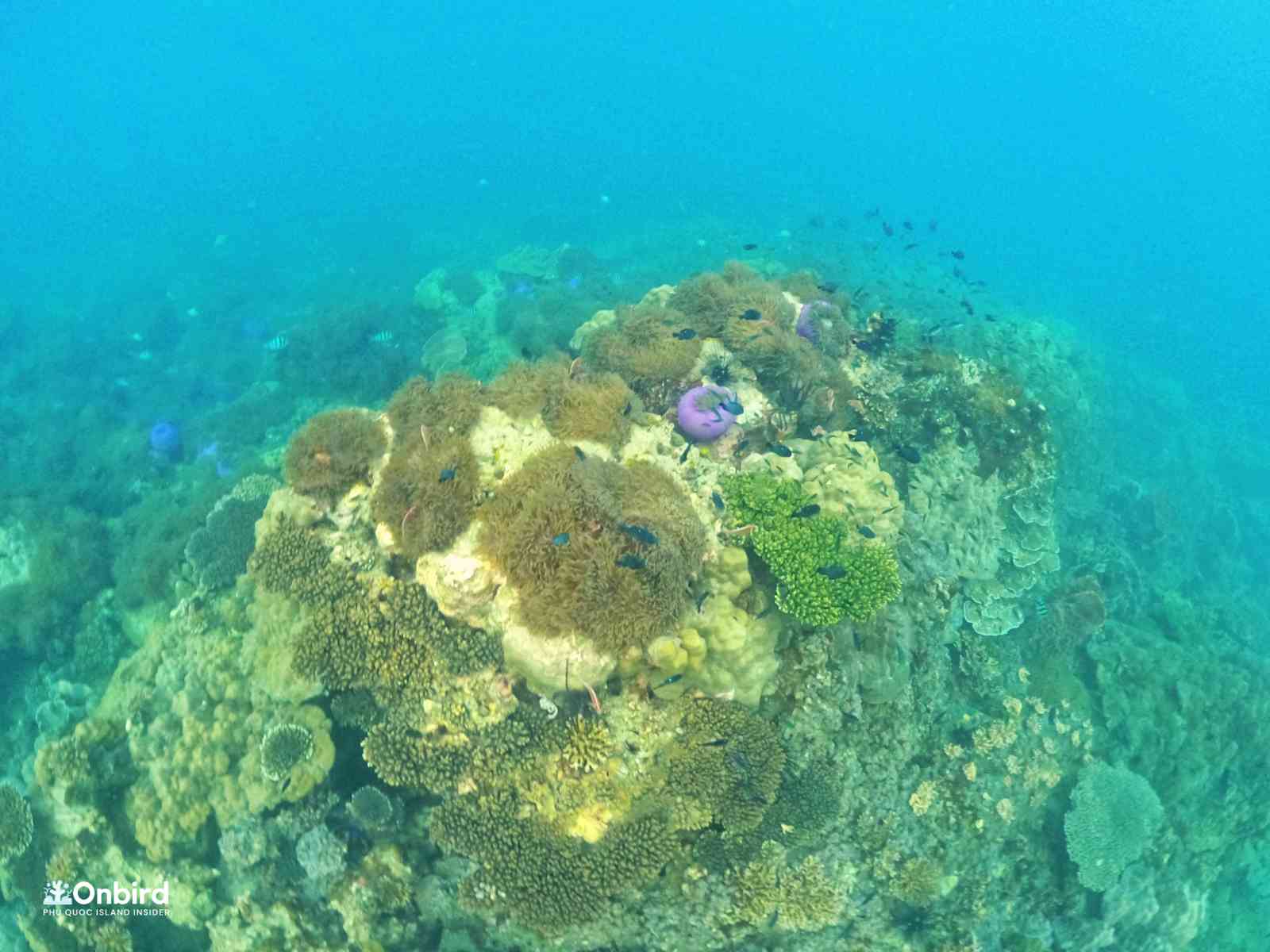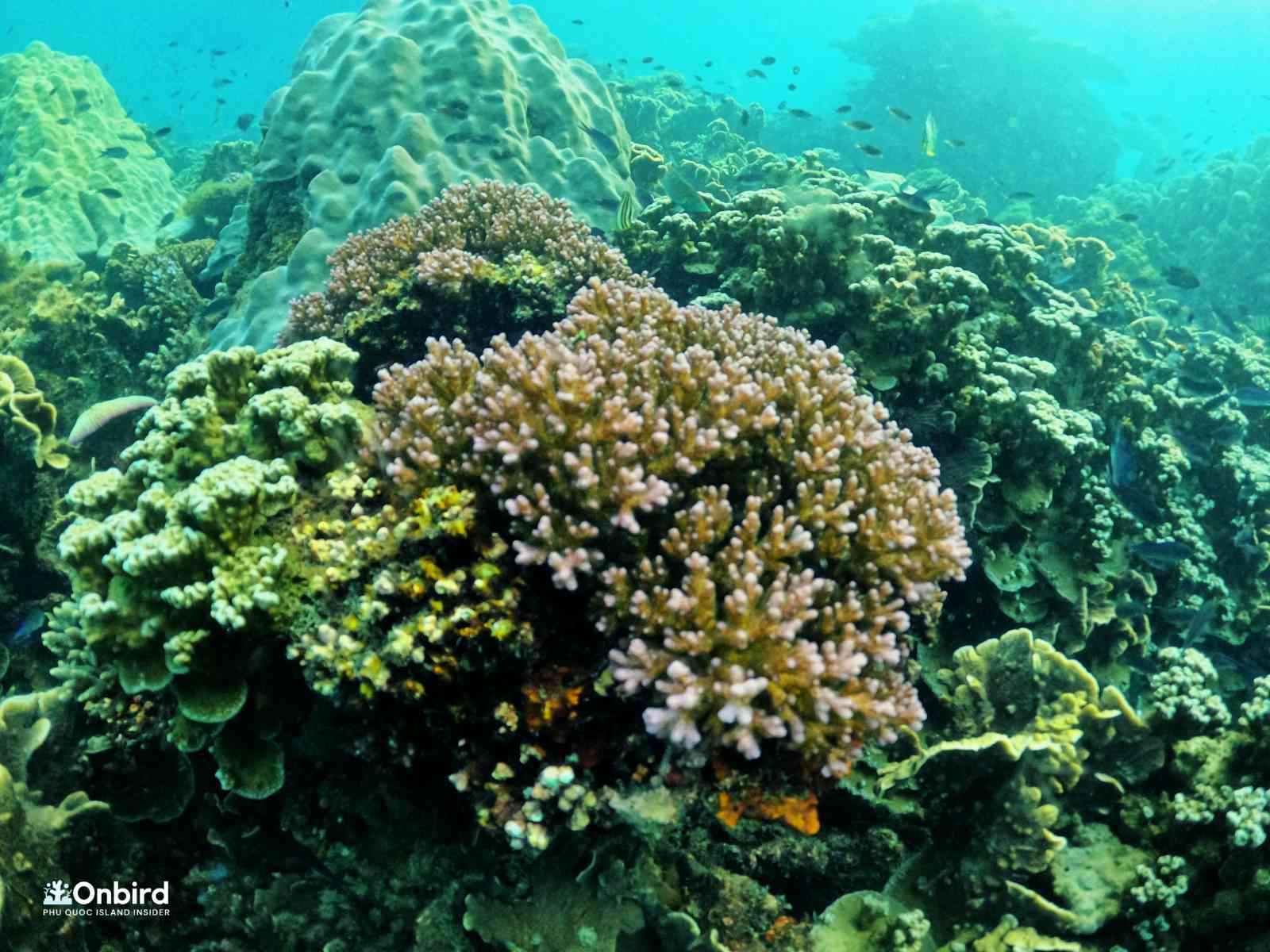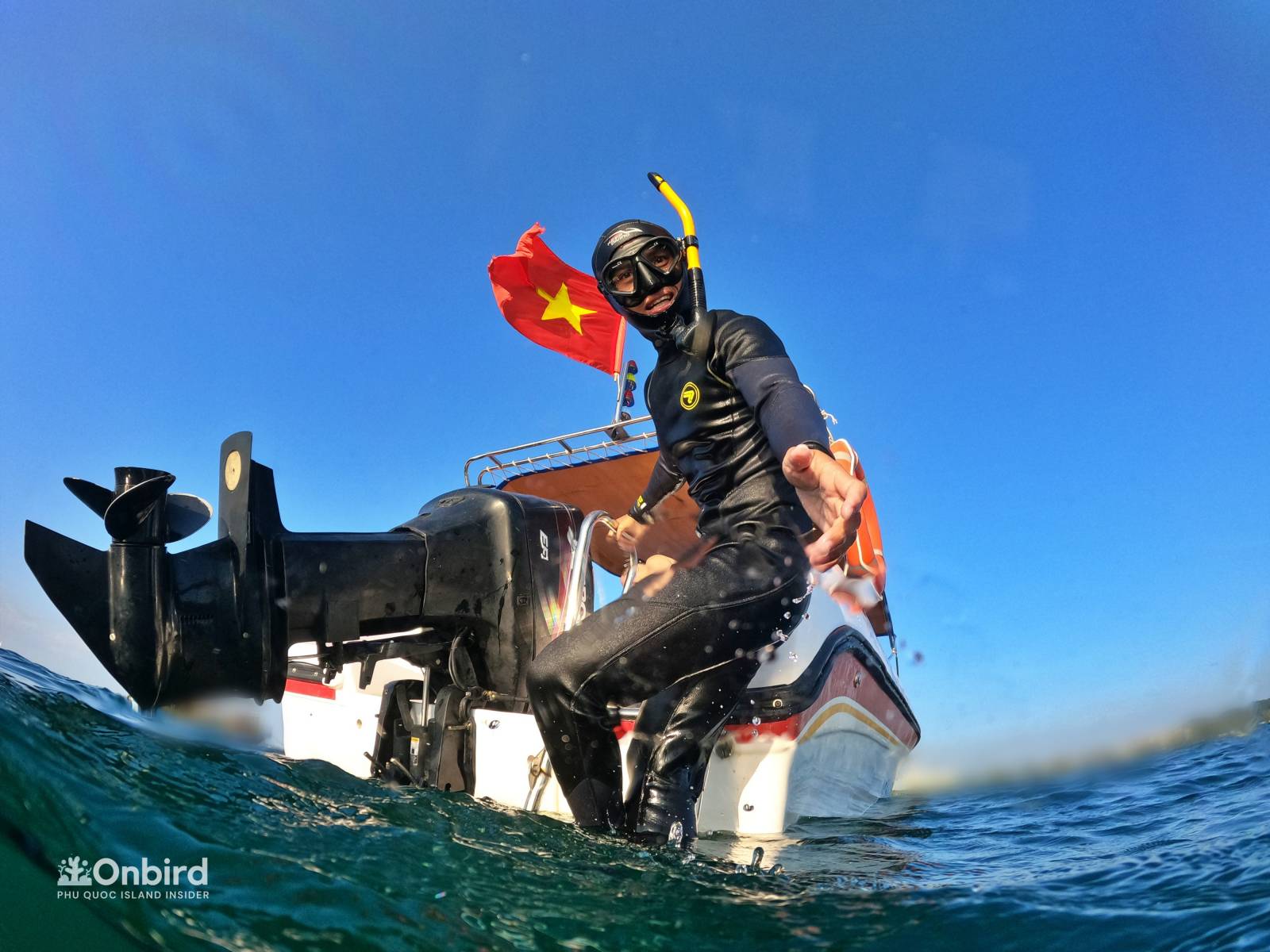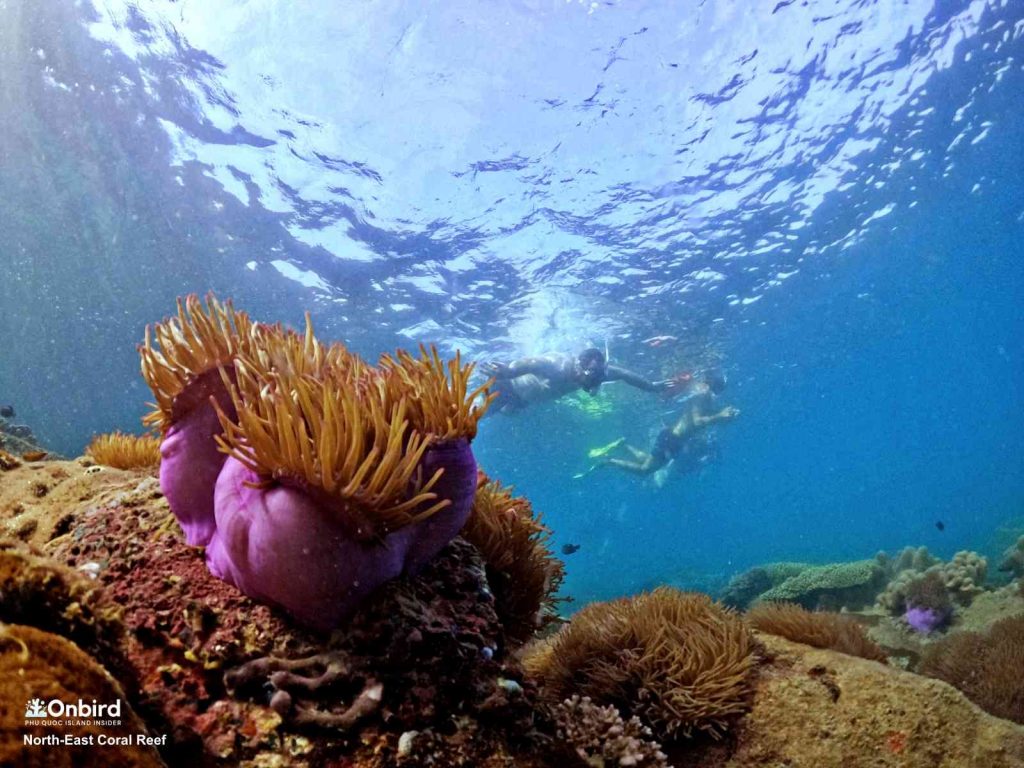In this post, the OnBird team would like to share with you advanced information about the lighting effect and how it could affect your snorkelling & diving experience.
All regular snorkelling & diving tours will be conducted in the noon timeframe, but do you know how worse it is and how different OnBird’s scientific snorkeling experiences can maximize your experience?
Do you know that the proper timeframe is very important to the snorkelling experience? OnBird is proud to be the very first pioneer in the industry to point out this factor as well as introduce our Scientific Snorkeling to professional snorkelers and divers for those who have a great passion for the coral world.
Scientific Snorkeling by OnBird Phu Quoc is a professionally organized snorkeling experience that takes into account external factors (water conditions, lighting effect) to maximize the snorkeling experience, and coral view and make advanced recommendations beforehand (based on OnBird water condition data) to choose the best spots for snorkeling & scuba diving in Phu Quoc Island, Vietnam.

Unlike what people often think: High sunlight does not make corals more colorful but more fade and blur, why? Please read OnBird’s advanced explanation below, we are going through 4 factors to prove why the strong sun doesn’t make your snorkeling better?
MAIN CONTENTS
- The composition of sunlight and Ultraviolet Lighting (UV rays)
- Coral Sunscreen Mechanism & Corals’ Fluorescent ”Sunscreen
- Strong sun with strong UV & abundant high-energy lighting & Invisible pigments
- Solar Noon: The maximum UV level Timeframe
- Strong-UV-Avoiding Snorkeling by OnBird Phu Quoc
- Ultraviolet (UV) radiation’s effects on human health
- UV RAY-Avoiding Snorkeling Experience
- UV-Protect Lens Diving Mask
The composition of sunlight and Ultraviolet Lighting (UV rays)
Sunlight includes wavelengths of light that include every color human eyes can detect from the small light waves that make us perceive purple and violet to the wider light waves that our eye sees as bright red. However, the spectrum of light doesn’t stop with what we (humans) can see. Like the frequency of a fish, shrimp, or turtle, there are frequencies of light beyond our range of perception, wavelengths longer than red are “infrared” and wavelengths smaller than violet are known as “ultraviolet”. Together, sunlight has ultraviolet radiation, infrared radiation, and visible spectrum radiation.
The spectrum of light is measured by the size of their wavelengths – from peak to peak- in a microscopic increment called nanometers. One nanometer is one billionth of a meter – or one millionth the size of a millimeter – an extremely small distance. A human hair is approximately 75,000 nanometers thick while a single molecule of water is about 0.25 nanometers at its widest. The longest infrared wavelengths are around 4045 nanometers and the smallest ultraviolet wavelengths are 100 nanometers. The spectrum of visible colors to human eyes is in between, extending from 380 nm for visible violet to 780 nm for visible red.
An important quality of electromagnetic radiation is that it exists in indivisible quanta called “photons.” Photons act like little particles under certain circumstances. Photons are quanta. They sometimes act like waves and sometimes act like particles but are neither. They just are what they are.
It’s important to know about them because each photon carries energy and interacts with matter. Photons with wavelengths shorter than UV light have enough energy to break chemical bonds, those below UV light don’t. Thereby, UV-radiation can damage the coral’s DNA, if UV-radiation exceeds the capacity of the coral to repair their DNA the damage can become irreversible so coral develops their self-protection mechanism from UV-radiation as well as other strong-energy lighting or Corals’ Fluorescent ”Sunscreen”.
Coral Sunscreen Mechanism & Corals’ Fluorescent ”Sunscreen
To protect themself from strong-energy lighting which can damage coral’s DNA, coral relies on photosynthesis algae which create pigments to absorb strong-energy lighting (which is invisible to human eyes) through a phenomenon called fluorescence: coral absorb strong-energy lighting (short wavelengths lighting) and emit lower-energy lighting (wider wavelengths lighting), as the stronger sun the more pigment photosynthesis need creating as strong-energy lighting can also destroy coral pigments. During this coral fluorescence, photosynthesis algae create the same corresponding pigment to the strong-energy lighting for better absorbance as well as stronger protection.
Strong sun with strong UV & abundant high-energy lighting & Invisible pigments
So strong sun means that UV rays as well as high-energy lighting are abundant. So under strong sun, coral triggers their sunscreen mechanism at its strongest. At that time more invisible pigments are created to absorb strong-energy lighting and emit invisible lighting.
And because they are all invisible to human eyes even coral glows at its strongest thanks to the strongest fluorescence phenomenon under the strongest sun but the colors are still invisible to human eyes so corals do not look colorful to human eyes under the strong sun.
In conclusion by OnBird: Under a strong sun, corals do not glow colorful to human eyes but are less colorful or more blurred.
Solar Noon: The maximum UV level Timeframe
The index predicts the risk of UV overexposure using a scale that ranges from 0 (minimal risk) to 11+ (very high risk). The levels of UV radiation (and therefore the values of the index) vary throughout the day. The maximum UV level on any given day occurs during the four hours between 10 a.m. and 2 p.m., which OnBird labels a worse timeframe for snorkeling), a timeframe scientists refer to as ‘solar noon”.
A UV Index of 8-10 (Very High) means there is a high risk of harm from unprotected sun exposure (for example: Fair-skinned people may burn in less than 10 minutes). Minimize as much sun exposure as possible during the midday hours of 10 a.m. to 2 p.m.
A UV Index of 11+ (Extreme) means there is a very high risk of harm from unprotected sun exposure (for example: Fair-skinned people may burn in less than 5 minutes). Outdoor workers and vacationers who can receive very intense sun exposure are especially at risk.
Strong-UV-Avoiding Snorkeling by OnBird Phu Quoc
For the best coral view experience, OnBird scientifically takes into account the lighting effects especially the effect of strong as well as high-energy lighting, we arrange strong-UV-avoiding snorkeling experiences to bring guests to see the corals at their best status to human eyes in the most colorful status in natural.
This is even more important for a good coral view experience for adults and elders, as prolonged exposure to UV rays modifies lens proteins, leading to cataract formation and worsening eyesight. Over time, cataracts can make vision blurry, hazy, or less colorful, thereby the elders with eye disorders and diseases detect corals as less colorful than the young.

Ultraviolet (UV) radiation’s effects on human health
Overexposure to UV radiation can lead to serious health issues, including cancer. There are also different types of UV rays, based on how much energy they have. Higher-energy UV rays are a form of ionizing radiation. This means they have enough energy to remove an electron from (ionize) an atom or molecule. Ionizing radiation can damage the DNA (genes) in cells, which in turn may lead to cancer. But even the highest-energy UV rays don’t have enough energy to penetrate deeply into the body, so their main effect is on the skin.
Anyone can have harmful health effects from UV radiation, but the risks increase in people who:
- Spend a lot of time in the sun or have been sunburned.
- Have light-colour skin, hair, and eyes.
- Take some types of oral and topical medicines, such as antibiotics, birth control pills, and benzoyl peroxide products, as well as some cosmetics, may increase skin and eye sensitivity to UV in all skin types.
- Have a family member with skin cancer.
- Are over age 50
UV RAY-Avoiding Snorkeling Experience
For a better Snorkeling and coral experience:
OnBird would like to introduce our Scientific Snorkeling (morning or afternoon based on water conditions) which is professionally organised based on external factors (water conditions, lighting effect) which is also to avoid strong UV Ray timeframe thereby we can maximize and bring snorkelers and divers a much better experience of seeing the corals and fish with more colorful. In reverse, scuba diving is much more preferable to explore in this timeframe as strong lighting can travel deeper through the water.
For a Coral-friendly Snorkeling experience:
By avoiding a strong UV Ray timeframe, we can also reduce a lot of sunscreens even if they are reef-friendly labelled which we always highly recommend guests not use but wear a long-sleeve shirt to protect their skin instead.
Protect snorkelers & divers from UV rays’ harmful effects: By avoiding maximum UV ray level timeframe, we can protect ourselves better when doing snorkelling, but we always recommend guests use long-sleeve shirts to protect themselves in the water from many other things.

UNDERWATER INSTRUCTORS MAKE YOUR SNORKELING EXPERIENCE DISTINCT
UV-Protect Lens Diving Mask
On top of that, for those who are professional divers or snorkelers who want to protect their eyes on snorkelling & diving time, you can consider arming yourself with a specialized Diving Mask that is made of UV-cut lens to protect your eyes against UV and HEV light in all weather conditions when diving & snorkelling.
In Phu Quoc Island, Vietnam you can visit our Diving & Snorkeling Equipment Shop (map) to see the high-quality options for UV-protect Diving Mask.
High-End UV-Protect Len Diving Mask for Diving and Snorkeling
Sustainable Small-Group Soft-adventure Snorkeling Tour – Amazing things to do in Phu Quoc Island



 日本語
日本語